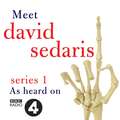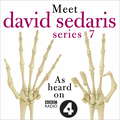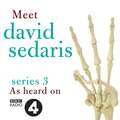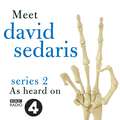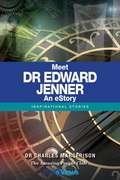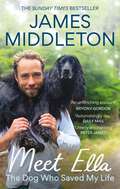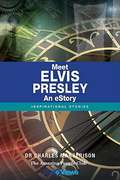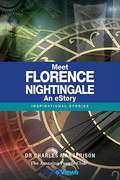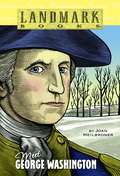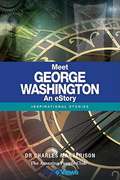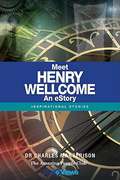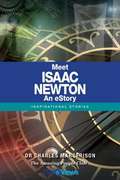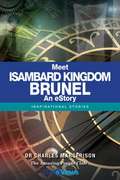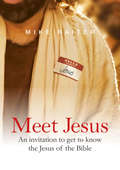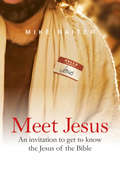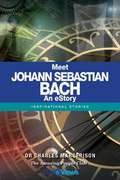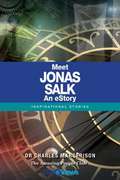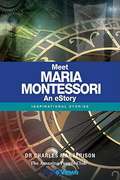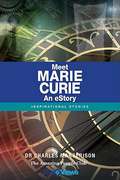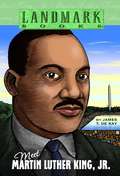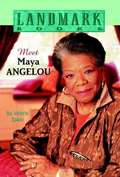- Table View
- List View
Meet David Sedaris: Series One (Radio 4 series)
by David SedarisDavid Sedaris's remarkable ability to uncover the hilarious absurdity teeming just below the surface of everyday life is surpassed only by his ability to make his stories even more hilarious when he reads them aloud. This is his first series for Radio 4, and he reads diary entries and essays from his books.Episode 1Six-to-Eight Black MenJust a Quick EmailEpisode 2Let It SnowThe Cat and the BaboonKeeping UpEpisode 3PicapocketoniI'll Eat What He's WearingEpisode 4KookaburaWith a Pal Like This
Meet David Sedaris: Series Seven (Radio 4 series)
by David SedarisNamed by Time as America's Favourite Humorist, the uniquely perceptive and hilarious David Sedaris reads from his essays and diaries for his seventh series for Radio 4. This is the complete recording of Meet David Sedaris Series Seven, which was broadcast on Radio 4. The full listing is:Episode One: Father TimeDiary entries - 'October 10th, Frankfurt', 'April 24th 2014; Austin, Texas', 'February 8th 2017, London'Episode Two: The GodfatherDiary entries - 'December 22nd 2018, London', 'March 26th 2018, London', 'April 23rd 2018, St. Louis', 'August 26th 2017, Rackham West Sussex'Episode Three: The Silent TreatmentDiary entries - 'July 26th 2015, London', 'July 1st 2017, Raleigh', 'May 14th 2017, Anchorage'Episode Four:Why Aren't You Laughing? Episode Five:Active ShooterDiary Entries - 'July 18th 2018, Newcastle', 'March 7th 2018, London', 'December 20th 2018, Albuquerque' Episode Six:CNNBoo Hooey Million Dollar Ideas
Meet David Sedaris: Series Three (Radio 4 series)
by David SedarisDavid Sedaris's remarkable ability to uncover the hilarious absurdity teeming just below the surface of everyday life is surpassed only by his ability to make his stories even more hilarious when he reads them aloud. This is his third series for Radio 4, and he reads diary entries and essays from his books.Episode 1AttaboyIn the Waiting RoomEpisode 2Author AuthorFront Row Centre With Thaddeus BristolEpisode 3Memory LapseIf I Ruled the WorldEpisode 4Put a Lid on ItEpisode 5Easy TigerPossessionEpisode 6RubbishJesus Shaves
Meet David Sedaris: Series Two (Radio 4 series)
by David SedarisDavid Sedaris's remarkable ability to uncover the hilarious absurdity teeming just below the surface of everyday life is surpassed only by his ability to make his stories even more hilarious when he reads them aloud. This is his second series for Radio 4, and he reads diary entries and essays from his books.Episode 1The Incomplete QuadThe Squirrel and the ChipmunkEpisode 2Me Talk Pretty One DayIt's CatchingEpisode 3Nuit of the Living DeadThe End of the AffairEpisode 4Us and ThemDiary extractsEpisode 5Memento MoriThe Motherless BearEpisode 6The Ship ShapeMake That a Double
Meet Dr Edward Jenner - An eStory
by Charles MargerisonMeet, and be inspired by, Dr Edward Jenner; the 'Father of Immunology', the pioneer of the smallpox vaccine and the man whose works have saved more lives than any other's as he reveals his own incredible story. Follow Dr Jenner's fascinating life journey from student to general practitioner and surgeon, to his astounding, innovative research into vaccination. This audiobook offers an accessible and unique way to discover his amazing life story.Dr Edward Jenner's story comes to life through BioViews®, which are short biographical narratives, similar to interviews. These inspirational stories from The Amazing People Club® provide a new way of learning about amazing people who made major contributions and changed our world.
Meet Ella: The Dog Who Saved My Life
by James Middleton'It's been a long time since a book has touched me this much. Beautifully written, utterly enchanting, searingly honest and deeply moving' - Peter James, bestselling author and creator of the Superintendent Roy Grace series'Meet Ella is so profoundly moving. It greatly resonated with me, both personally and professionally, and James' story is written so beautifully, and with such clarity and honesty' - Joanna Cannon, bestselling author of The Trouble with Goats and SheepWhen he was a child, James Middleton wanted nothing more than a dog of his own. Struggling to connect in the classroom, James would often take off in pursuit of nature and animals - adventuring in the Berkshire countryside, tinkering with rusty farm machinery, performing locum care to injured creatures, and losing himself for hours to the outdoors.Then, finally, his pleas for a dog (made via handwritten letters to his parents) were answered.Meet Ella traces the extraordinary bond between James and his beloved first pup, Ella. From their enchanting introduction when James was just twenty and their many expeditions, from Scottish mountain sides to royal weddings, their journey is marked by love, loyalty, and unexpected twists of fate. Ella, the well-mannered and kind-natured companion, accompanied James everywhere, even playing a pivotal role in introducing him to his future wife, Alizee.But beyond the glamorous veneer of society engagements and entrepreneurial achievements lies a deeply personal account of James' battle with depression. Through unconditional love, Ella emerges as an intuitive friend, reading James' moods and offering solace during his darkest hours, becoming the catalyst for his healing journey, and helping him to see all the good in his life and future.Touching, honest and life affirming, Meet Ella is both devastating and wonderfully heart-warming. A love letter to man's best friend, and a beacon of hope to anyone struggling through hard times.
Meet Ella: The Dog Who Saved My Life
by James MiddletonTouching, honest and life affirming, Meet Ella is a love letter to man's best friend, and a beacon of hope to anyone struggling through hard times.When he was a child, James Middleton wanted nothing more than a dog of his own. Struggling to connect in the classroom, James would often take off in pursuit of nature and animals—exploring the Berkshire countryside, tinkering with rusty farm machinery, caring for injured creatures, and losing himself for hours to the outdoors. Then, finally, his pleas for a dog (made via handwritten letters to his parents) were answered. Meet Ella traces the extraordinary bond between James and his beloved first pup, Ella. From their enchanting introduction to their many adventures, from Scottish mountain sides to royal weddings, their journey is marked by love, loyalty, and unexpected twists of fate. Ella, a well-mannered and kind-natured companion, accompanied James everywhere, even playing a pivotal role in introducing him to his future wife, Alizee. But beyond the glamorous veneer of society engagements and entrepreneurial achievements lies a deeply personal account of James' battle with depression. Through unconditional love, Ella emerges as an intuitive friend, reading James' moods and offering solace during his darkest hours, becoming the catalyst for his healing journey, and helping him to see all the good in his life and future. By turns tender and poignant, Meet Ella is a wonderfully heart warming celeration of an unbreakable bond and the amazing healing potential of the human-animal connection.
Meet Ella: The Dog Who Saved My Life
by James Middleton'It's been a long time since a book has touched me this much. Beautifully written, utterly enchanting, searingly honest and deeply moving' - Peter James, bestselling author and creator of the Superintendent Roy Grace series'Meet Ella is so profoundly moving. It greatly resonated with me, both personally and professionally, and James' story is written so beautifully, and with such clarity and honesty' - Joanna Cannon, bestselling author of The Trouble with Goats and SheepWhen he was a child, James Middleton wanted nothing more than a dog of his own. Struggling to connect in the classroom, James would often take off in pursuit of nature and animals - adventuring in the Berkshire countryside, tinkering with rusty farm machinery, performing locum care to injured creatures, and losing himself for hours to the outdoors.Then, finally, his pleas for a dog (made via handwritten letters to his parents) were answered.Meet Ella traces the extraordinary bond between James and his beloved first pup, Ella. From their enchanting introduction when James was just twenty and their many expeditions, from Scottish mountain sides to royal weddings, their journey is marked by love, loyalty, and unexpected twists of fate. Ella, the well-mannered and kind-natured companion, accompanied James everywhere, even playing a pivotal role in introducing him to his future wife, Alizee.But beyond the glamorous veneer of society engagements and entrepreneurial achievements lies a deeply personal account of James' battle with depression. Through unconditional love, Ella emerges as an intuitive friend, reading James' moods and offering solace during his darkest hours, becoming the catalyst for his healing journey, and helping him to see all the good in his life and future.Touching, honest and life affirming, Meet Ella is both devastating and wonderfully heart-warming. A love letter to man's best friend, and a beacon of hope to anyone struggling through hard times.
Meet Elvis Presley - An eStory
by Charles MargerisonMeet Elvis Presley, a cultural icon all over the world and one of the most famous singers of the 20th century. You may know and love many of his songs and movies, but how much do you know about his real life? In this unique audio story from The Amazing People Club, gain new insight on the real life of the "The King" and follow him from the two-room shotgun house in Tupelo where he was born to the time he first walked into Sun Records in Memphis, which changed his life. Gain a fascinating insight on Elvis' life and better understand the man behind the legend through BioViews®.A BioView® is a short biographical story, similar to an interview. These unique audio stories provide an easy way of learning about amazing people who made major contributions to our world.
Meet Florence Nightingale - An eStory
by Charles MargerisonMeet Florence Nightingale, also known as The Lady with the Lamp. From a very young age, she was on a mission to care for others. She laid the foundations for the first nursing school and demonstrated amazing courage during the Crimean War, taking care of countless injured soldiers. Be inspired by her amazing story reflected in her BioView®.Each story comes to life through BioViews®. These are short biographical narratives, similar to interviews. They provide an easy way of learning about amazing people who made major contributions and changed our world.
Meet George Washington (Landmark Books)
by Joan HeilbronerThis valiant story of how young George Washington was drawn into his country's struggle for independence gives readers a vivid perspective on a crucial era in American history--and on the life of a revolutionary hero. From the Trade Paperback edition.
Meet George Washington - An eStory
by Charles MargerisonGeorge Washington grew up in the English colony of Virginia. He was tall and strong and respected by his friends and colleagues as a good leader. As he grew older, George saw how England took advantage of the American colonies and he didn't like it. When the colonies declared their independence, George was chosen to lead their army as its general. When the colonies finally won their freedom, George was elected to lead the new nation as its first president.Each story comes to life through BioViews®. These are short biographical narratives, similar to interviews. They provide an easy way of learning about amazing people who made major contributions and changed our world.
Meet Helen Keller - An eStory
by Charles MargerisonBeing able to see and hear are gifts that many of us take for granted. In this inspirational title from The Amazing People Club, you will get to hear the amazing Helen Keller story. Follow her journey from early childhood where frustration, confusion and anger were part of her everyday life. Discover what made her go on to become the first deaf and blind person to earn her degree. Her motivations and fighting spirit led her to proceed to travel the world to educate people on politics and women's rights. Despite disabilities, she succeeded in many ways, making major contributions to our world. Her story comes to life through BioViews®. These are short biographical narratives, similar to interviews. They provide an easy way of learning about amazing people who made major contributions and changed our world.
Meet Henry Wellcome - An eStory
by Charles MargerisonMeet Henry Wellcome. Discover his amazing life story in this unique audio story from The Amazing People Club. He may have saved your life with the medicines he developed and produced. Henry willed his entire fortune to further development and research to The Wellcome Trust, which is one of the largest biomedical charities in the world. Travel with Henry Wellcome from the log cabin in which he was born in Wisconsin on his epic journeys around the world, driven by his thirst for knowledge and insatiable curiosity. Henry Wellcome's story comes to life through BioViews®. These are short biographical narratives, similar to interviews. They provide an easy way of learning about amazing people who made major contributions and changed our world.
Meet Isaac Newton - An eStory
by Charles MargerisonMeet Isaac Newton, author of The Principia and arguably one of the most influential figures in science, responsible for major developments such as the Theory of Gravity. Explore his amazing story through BioViews® which follows Newton as a young child in a troubled home through to his adult life where his research and explorations brought him to conclusions that really changed the world was understood. A BioView® is a short biographical story, similar to an interview. These inspirational stories provide an easy way of learning about amazing people who made major contributions to our world.
Meet Isambard Kingdom Brunel - An eStory
by Charles MargerisonMeet, and be inspired by, Isambard Kingdom Brunel, the great British genius of civil engineering, as he tells his own incredible story. As a young boy, Brunel was taught by his father, the eminent engineer Marc Isambard Brunel. Brunel worked with his father on the famous Thames Tunnel, the first tunnel underneath a navigable river. Isambard went on to become a great innovator in civil engineering, creating many famous 'firsts' including the incredible Clifton Suspension Bridge and the SS Great Britain. He was also the great mind behind the Great Western Railway. Isambard Kingdom Brunel's story comes to life through BioViews®, which are short biographical narratives, similar to interviews. These inspirational stories from The Amazing People Club provide a new way of learning about amazing people who made major contributions and changed our world.
Meet Jesus: An invitation to get to know the Jesus of the Bible
by Mike RaiterI want you to meet a friend of mine: Jesus Christ. He’s someone who wants to meet you.I’m sure you have heard about Jesus. You may know a lot about him. You may know very little about him. You may have been told things about Jesus and you’re not sure if they’re true. In this book I want you to hear the truth about Jesus.Jesus came to bring us good news. He taught us about God and how we can know God. He came to give us life that lasts forever. That’s good news!Followers of Jesus believe that meeting him is the best thing that ever happened. That’s why they want to share the good news about Jesus and what he has done for them.We hope you enjoy meeting Jesus.
Meet Jesus: An invitation to get to know the Jesus of the Bible
by Mike RaiterI want you to meet a friend of mine: Jesus Christ. He’s someone who wants to meet you.I’m sure you have heard about Jesus. You may know a lot about him. You may know very little about him. You may have been told things about Jesus and you’re not sure if they’re true. In this book I want you to hear the truth about Jesus.Jesus came to bring us good news. He taught us about God and how we can know God. He came to give us life that lasts forever. That’s good news!Followers of Jesus believe that meeting him is the best thing that ever happened. That’s why they want to share the good news about Jesus and what he has done for them.We hope you enjoy meeting Jesus.
Meet Johann Sebastian Bach - An eStory
by Charles MargerisonMeet and be inspired by a musical genius, as Johann Sebastian Bach tells his own incredible story in this fascinating eStory from The Amazing People Club®. Born into a musical family, he was taught by his father and his uncle using a huge variety of instruments. Johann became a brilliant multi-instrumentalist and a highly respected organist and teacher of music. Though his compositions were not given the respect they were due in his lifetime, Bach's work was an enormous inspiration for the great composers who followed him. Beethoven described Johann Sebastian Bach as 'the original father of harmony'. Follow Bach's incredible life journey and learn how he came to change the face of music forever. Johann Sebastian Bach's story comes to life through BioViews® which are short biographical narratives, similar to interviews. These inspirational stories from The Amazing People Club® provide a new way of learning about amazing people who made major contributions and changed our world.
Meet Jonas Salk - An eStory
by Charles MargerisonMeet, and be inspired by, Jonas Salk; the man who developed the polio vaccine, as he tells his own incredible story. From his humble beginnings as the son of Russian-Jewish immigrants in New York City, Jonas became the first member of his family to go to college. He quickly became fascinated by medical science, and his work on the influenza virus was a great success, preventing further epidemics like those that killed so many people in the wake of the First World War. This research helped Salk in the years of painstaking human trials he conducted, trying to develop a vaccine for the polio virus. Polio epidemics had caused misery and anxiety for parents of children in 1950s America. Not only was Salk's work a success; he also refused to profit from his vaccine by patenting it.Jonas Salk's story comes to life through BioViews® which are short biographical narratives, similar to interviews. These inspirational stories from The Amazing People Club® provide a new way of learning about amazing people who made major contributions and changed our world.
Meet Mahatma Gandhi - An eStory
by Charles MargerisonMahatma, meaning great soul, is the name by which we all know the inspirational Mohandas (Mahatma) Gandhi. In this unique life story from The Amazing People Club, you are invited to share in the thoughts and mindset of this resolute peace lover. His compassion and respect for those around him played a pivotal part in history as he promoted non-violence towards all living beings. During his life he endured many hardships in his ambition to free the people of India and obtain equal rights. There is much that we can learn from this amazing character who is fondly remembered as the Father of the Indian Independence Movement. His story comes to life through BioViews®. These are short biographical narratives, similar to interviews. They provide an easy way of learning about amazing people who made major contributions and changed our world.
Meet Maria Montessori - An eStory
by Charles MargerisonMeet Maria Montessori! Many people do not know that she was actually the first female doctor in Italy. She believed education was essential in the achievement of peace and went on to develop a revolutionary teaching method. It grew into a movement that she helped to spread all over the world. Be amazed by her fascinating story, as it comes to life through BioViews®.A BioView® is a short biographical story, similar to an interview. These unique audio stories provide an easy way of learning about amazing people who made major contributions to our world and can help you achieve your ambitions in your journey through life.
Meet Marie Curie - An eStory
by Charles MargerisonMeet Marie Curie! She was the first person in the world to be honored with two Nobel Prizes. Gain a unique insight into her amazing life and what actually inspired her. Get a personal insight into her relationship with her husband, Pierre. Be inspired by her amazing story as it comes alive through BioViews®?A BioView® is a short biographical story, similar to an interview. These unique stories provide an easy way of learning about amazing people who made major contributions to our world.
Meet Martin Luther King, Jr. (Landmark Books)
by James T. de KayIllus. with black-and-white photos. This revised edition of the popular Random House Step Up(TM) Biography of the great civil-rights leader and advocate for peaceful resistance now includes new text and additional dynamic photos. Reading level: 2.2. From the Trade Paperback edition.
Meet Maya Angelou
by Valerie SpainA biography of the multifaceted African American woman Maya Angelou, tracing her life from her childhood in the segregated South to her prominence as a well-known writer.
